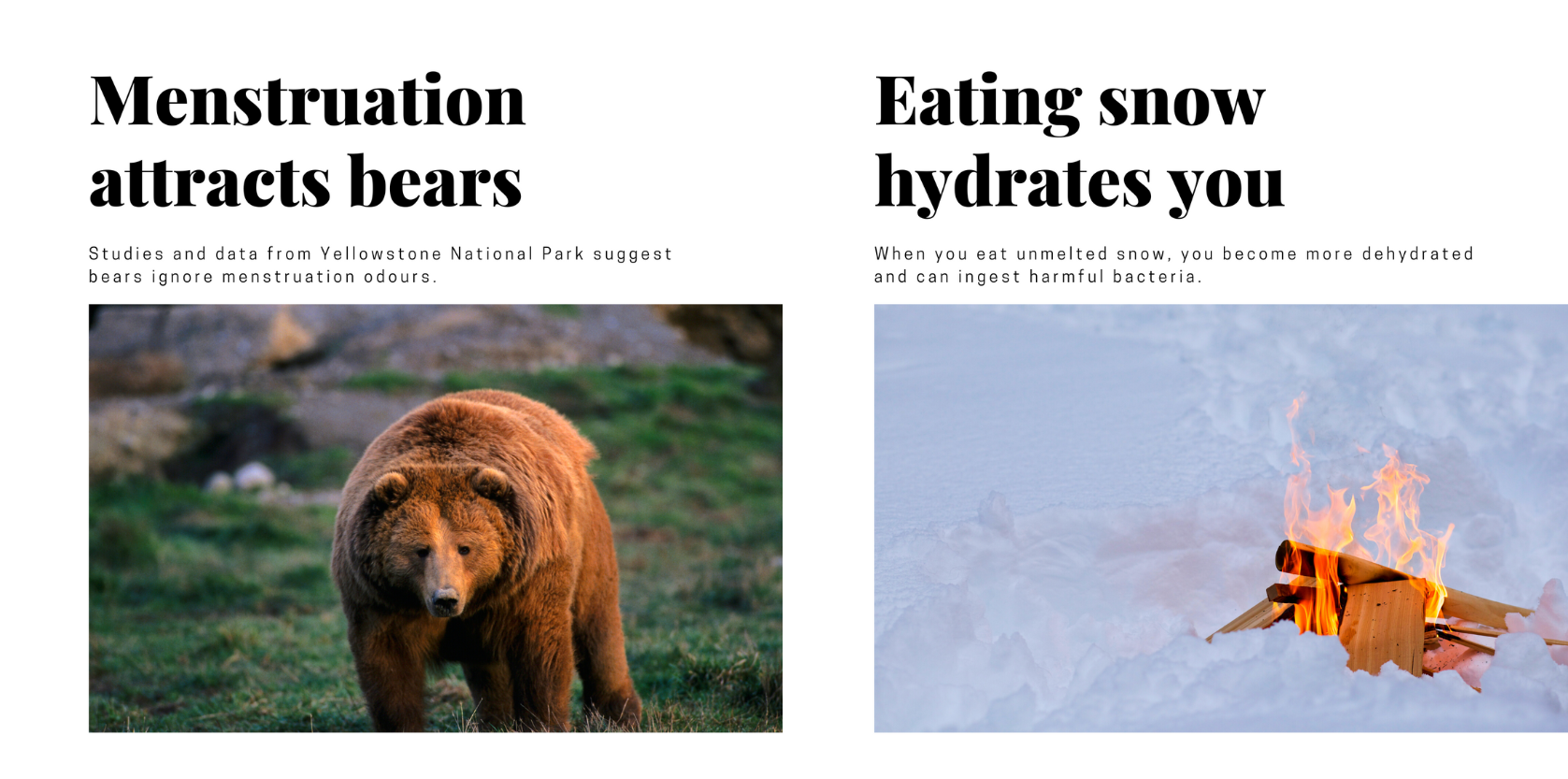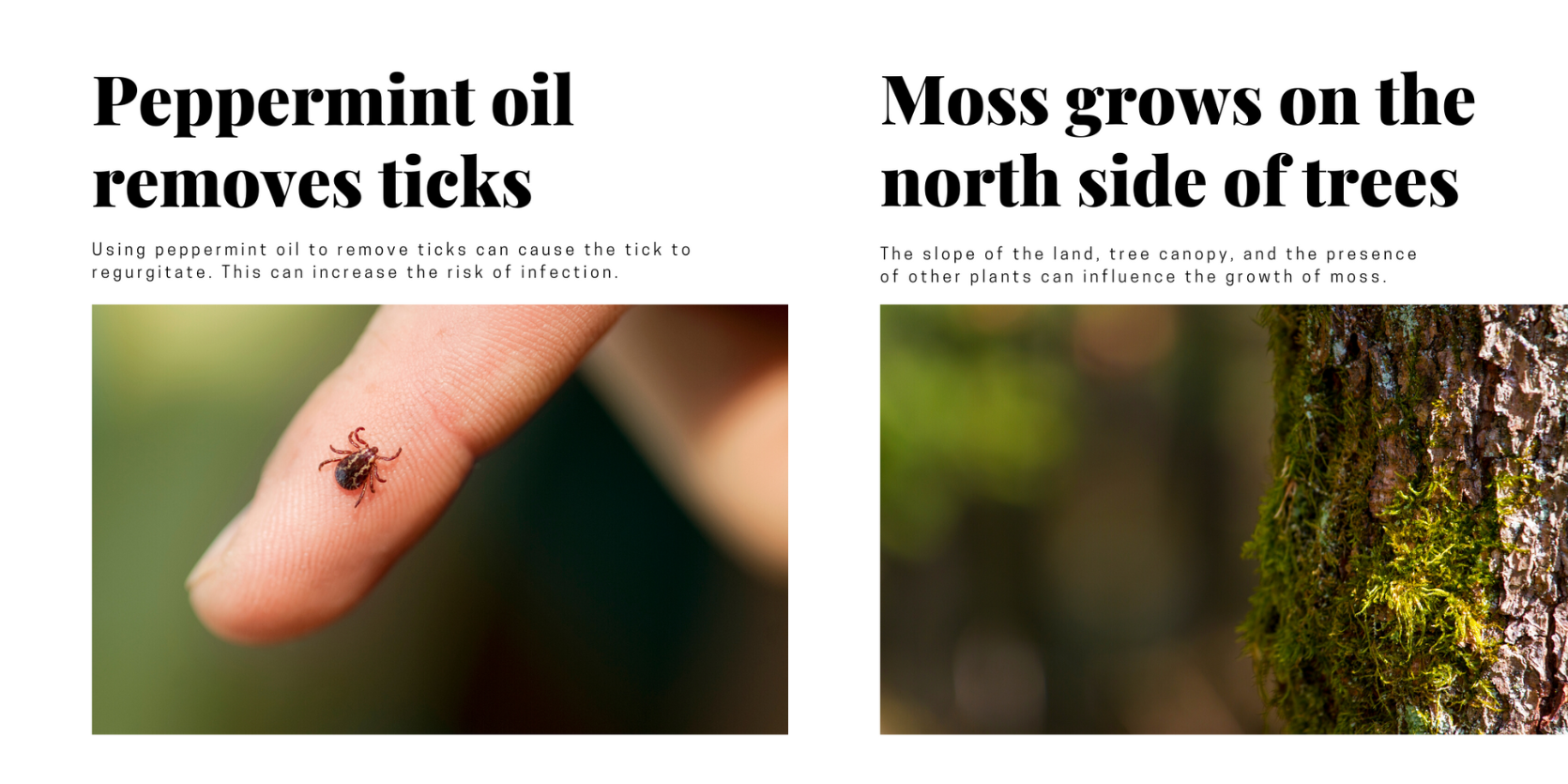If you love camping or hiking, you’ve probably come across a number of outdoor myths. While some of these myths are harmless or silly, others can be dangerous. From dangerous tick remedies to the belief that moss grows on the north side of trees, this post sets the record straight on a variety of outdoor myths and provide some tips on what you should do instead.
So, let’s get started and separate fact from fiction!

Sleeping Naked in a Sleeping Bag Keeps You Warmer
Every few months, I hear someone claim that sleeping naked in your sleeping bag is the best way to stay warm. As long as your clothes are dry and not constricting your circulation, wearing base layers inside your bag will keep you warmer during the night. In fact, third party testers determine the temperature rating for sleeping bags using a mannequin wearing a hat and base layers! So, you actually run the risk of lowering the temperature rating for your bag if you sleep naked.
Bear Bells Deter Bears
The jury is out on this one! The idea behind bear bells is that the noise will alert bears to the presence of humans, allowing them to avoid an encounter. Some studies suggests bear bells can be an effective deterrent,1 while others say that bears can become habituated to them or begin associating them with the presence of food in a backpack.2
Human Urine Repels Bears
Speaking of bears, there is no scientific evidence to suggest that human urine deters them. Bears have an excellent sense of smell and can detect odours from long distances. They are also opportunistic feeders, which means that they will eat a wide variety of foods, including human food and trash. Urine may actually attract them and increase the risk of a bear encounter. So, don’t pee near your campsite in the hope of deterring them!
Biodegradable Soap is Safe for Waterways
Even “eco-friendly” and “biodegradable” soaps impact the environment by contaminating water systems, which can harm insects, fish, and other aquatic organisms. Soaps alter the surface tension of water allowing for the absorption of harmful chemicals like pesticides by fish. Soaps can also destroy mucus layers that protect fish from bacteria and parasites, and can harm or kill fish eggs.3
Unfortunately, many people see the words eco-friendly and biodegradable and don’t realize the products they purchased shouldn’t enter waterways. This post explains how to wash dishes in the backcountry in a way that minimizes environmental impact.

Alcohol Warms You
Although alcohol may make you feel warm for a short time, it actually causes your body to lose heat faster. This is because alcohol dilates your blood vessels sending heat away from your core. As a result, your body’s core temperature can drop, leading to hypothermia in extreme cases. In addition, alcohol impairs your judgment and coordination, which can increase your risk of accidents or injuries that can further contribute to heat loss.4 It’s important to keep these effects in mind when consuming alcohol in cold weather.
Peppermint Oil Removes Ticks
Using peppermint oil or other essential oils to remove ticks can cause the tick to regurgitate, increasing the risk of infection. To safely remove a tick, use fine-tipped tweezers or a tick-removal tool to grasp the tick as close to the skin as possible. Gently pull the tick straight out, taking care not to twist or squeeze the tick, which can cause its mouthparts to break off and remain in the skin. After removing the tick, clean the bite area with rubbing alcohol or soap and water.5 If you are worried about Lyme disease, place the tick in a sealed container with the date you removed it written down. Many provinces allow you to send ticks to a public health unit to test for the bacteria that causes Lyme.
To safeguard yourself from ticks, wear clothing that is light in colour. This will make it simpler to spot any ticks that have hitched a ride on your clothing. Tucking your pants into your socks, wearing long-sleeved shirts, and keeping long hair tied back will also help keep ticks off. Using products with DEET or clothing treated with permethrin is proven to repel ticks.
Eat Garlic to Stop Mosquitoes From Biting
While garlic has a strong odour that some people may find unpleasant, it is not likely to repel ticks or mosquitoes. The University of Connecticut Health Centre conducted a 2005 study in which they tested a group of people who had consumed a significant amount of garlic and a placebo group. The study found no reliable evidence that garlic can effectively repel mosquitoes.6 To protect against ticks and mosquitoes, use proven methods of prevention, like wearing insect repellent and long sleeves and pants.

Play Dead If a Bear Attacks
Experts recommend playing dead during aggressive encounters with grizzly bears, but advise against it for encounters with black bears. Use the saying “black fight back, brown go down” to help you remember this. That said, it’s important to keep in mind that bear behaviour can vary, and the best course of action will depend on the specific circumstances of the encounter. According to the National Park Service, if a grizzly bear attack persists, you should fight back. Or, if a bear stalks you or attacks you in your tent, you should also fight back. In these rare cases, the bear may view you as prey.
To avoid bear encounters, be aware of your surroundings, make noise, and carry bear spray when you’re in bear country. If you see recent signs of bear activity, avoid the area. It’s also important to familiarize yourself with the specific bear species that live in the area and to understand the different behaviours and responses that are appropriate for each type of bear.
Campground Firewood is Just a Money Grab
Campground firewood is, no doubt, expensive. But, resist the urge to bring in your own firewood as it can spread insects and diseases that harm local trees and ecosystems. Emerald ash borers, Asian long-horned beetles and many other types of wood-boring insects can move to new areas on firewood and infest and kill local trees. Oak wilt and Dutch elm disease can also spread through the movement of firewood.
By following these guidelines, you can help to protect local trees and ecosystems. And, if it makes you feel better, the steep price of firewood often goes back into park maintenance and conservation.
It’s Okay to Throw Organic Waste on the Ground
Organic food waste, like apple cores or orange peels, can take several years to break down in the environment. Before it decomposes, food waste can attract animals such as bears, raccoon, and rodents which can become a problem on trails or campsites. Worst case scenario, bears may start to associate humans with food, leading to conflict. This often ends with humans killing bears viewed as problematic.
To minimize the negative impacts of food waste in the outdoors, pack out all of your trash, including food waste, and to dispose of it properly in a designated trash receptacle. This helps protect animals and preserve the natural beauty of the environment.
Menstruation Increases the Likelihood of Bear Attacks
There is no scientific evidence to suggest that camping or hiking while menstruating increases the likelihood that you will attract bears or other predatory animals. In fact, one study shows that black bears ignore menstruation odours7 and data from Yellowstone National Park suggests it is highly unlikely that menstruation lures in bears.8 In 1992, the Interagency Grizzly Bear Committee launched a campaign to to dispel the menstruation myth.9 Unfortunately, people continue to repeat the misconception, which may prevent some women from participating in outdoor activities because of an unfounded fear.

Product Names on Sleeping Bags Reflect Thermal Ratings
Instead of relying on the product name, check for third-party approved EN/ISO ratings to determine the temperature rating of a sleeping bag. My “MEC Talon -10°C” sleeping bag has a comfort temperature rating of -4°C and a limit temperature rating of -30°C. The manufacturer may have chosen -10°C for marketing purposes or it may reflect the manufacturer’s internal testing or rating system, which may not be standardized or consistent with other manufacturers.
You Can Store Toothpaste or Deodorant in Your Tent
Scented toothpaste or deodorant can attract animals the same way as food scents. Avoid storing them in your tent. Instead, put them and other scented toiletries in your bear bag or bear canister.
Lost? Change Your Voicemail
Recently, a viral social media post instructed individuals to update their voicemail greeting with their location in the event they become lost in the wilderness. Since then, Search and Rescue organizations and emergency responders have been trying to dispel this dangerous advice. If you become lost, contact 911 directly and don’t waste your phone’s battery power trying to update your answering machine.10 Provide 911 with as much information as you can about your location, such as a nearby landmarks.
Catch and Release Doesn’t Harm Fish
While catch and release helps conserve fish populations, it can still harm fish through the process of hooking and handling. Physical damage to the scales, fins, and mouth of fish are common. In addition, the stress of being caught can negatively impact a fish’s growth, reproductive success, and susceptibility to disease. Barbless hooks and proper handling techniques can minimize the amount of harm done. I have a post discussing catch and release and how to minimizing its impacts on bass.
Moss Grows on the North Side of Trees
Moss grows best in cool, moist, and shaded environments. It is often found on the north side of trees because that side tends to receive less direct sunlight. However, other factors, such as the slope of the land, tree canopy, and the presence of other plants or structures, can also influence the growth of moss. Therefore, relying on moss growth as a directional device is often unreliable.
Drinking Urine Hydrates You in an Emergency
Urine is a waste product that the kidneys produce. It contains excess water, electrolytes, salts, and toxins that the body wants to get rid of. When the body lacks water, urine becomes more concentrated and may contain higher levels of these substances. The more urine you drink, the more dehydrated you will become because salts in your urine will draw water our of your cells.11 Additionally, the build up of toxins can cause kidney damage. All that said, a well-hydrated person is not likely to experience any issues drinking urine…but, why would you do that?

More Layers Always Keep You Warmer
It’s true that layering is essential for staying warm outside, but what layers you wear and how you wear them matters. Adding too many layers can actually reduce heat retention. Layering keeps you warm by trapping and warming air in your clothing. If you pile on layers in a constricting way, you decrease the amount of heat that is able to circulate. The type of materials you wear also matter. Some materials, such as wool or synthetic fleece, are better at trapping heat than others. They also help wick moisture away from the body. Materials like cotton will keep you wet and cold.
All Rain Gear Keeps You Dry
There are several factors that can impact the performance of rain gear and how well it keeps the wearer dry. Some materials like Gore-Tex or other waterproof and breathable fabrics keep water out while allowing sweat and moisture to escape. This prevents the wearer from getting too hot and uncomfortable. Other materials, such as rubber or plastic, may be less breathable and can cause the wearer to become sweaty and damp.
When selecting a raincoat or pant, ensure you verify its level of waterproofing. This information is typically expressed in millimetres. In general, a rating of at least 5000mm is suitable for light rainfall, while a rating of 15,000mm or higher is recommended for heavy rainfall. If you want to be fully protected in any weather condition, look for a rating of 20,000mm or greater.
Eating Snow Keeps You Hydrated
Another bad hydration tip! Eating snow does not hydrate you. When you eat snow, your body has to work to melt it, which can actually cause your body to lose water and become more dehydrated. Despite popular belief, snow also contains bacteria and needs to be purified. Check out this post about finding drinking water in winter conditions.
Ultrasonic Repellents Keep Bugs Away
Ultrasonic devices that “keep bugs away” keep showing up at outdoor retailers. Manufacturers claim that their high frequency sounds repel ticks and mosquitoes. Despite their claims, there is little scientific evidence to support the effectiveness of these devices. In fact, there are numerous peer-reviewed studies showing they do not work.12,13,14
What Outdoor Myths Have You Heard?
I hope this post helped to dismiss some popular outdoor myths. Please share with me any outdoor myths that you have heard so that we can continue this myth-busting session! Happy adventuring!
More Posts You May Enjoy
The Ultimate Fall Camping Guide
Building a Lean-To Shelter with Natural Materials
Where to Learn Outdoor Skills in Canada
Sources
1 Katherine L. Jope and Bo Shelby. 2009. “Hiker Behavior and the Outcome of Interactions With Grizzly Bears.” Leisure Sciences.
2 Timothy Floyd. 1999. “Bear-Inflicted Human Injury and Fatality.” Wilderness and Environmental Medicine.
3 Lenntech. “What Happens When Detergents Get Into Freshwater Ecosystems?“
4 Little and Stoner. 1981. “Body Temperature After Accidental Injury.” British Journal of Surgery.
5 Centers for Disease Control and Prevention. 2022. “Tick Removal and Testing.”
6 Anahad O’Connor. 2007. “The Claim: Eating Garlic Helps Repel Mosquitoes.” The New York Times.
7 Lynn Rogers, Gregory Wilker and Sally Scott. 1991. “Reactions of Black Bears to Human Menstrual Odors.” The Journal of Wildlife Management.
8 Kerry Gunther and Hopi Hoekstra. 1998. “Bear-Inflicted Human Injuries in Yellowstone National Park, 1970-1994.” International Association for Bear Research and Management.
9 Dave Smith. 2006. Backcountry Bear Basics: The Definitive Guide to Avoiding Unpleasant Encounters.
10 Reuters Fact Check. 2021. “Fact Check-Changing Cell-Phone Voicemail During an Emergency is Not Recommended.”
11 MSR Team. 2018. “Is It Safe to Drink Your Urine?“
12 Brown and Lewis. 1991. “The Efficacy of Ultrasonic Pest Controllers for Fleas and Ticks.” Journal of the South African Veterinary Association.
13 Amonrat Panthawong, Stephen Doggett, and Theeraphap Chareonviriyaphap. 2021. “The Efficacy of Ultrasonic Pest Repellent Devices against the Australian Paralysis Tick, Ixodes holocyclus (Acari: Ixodidae).” Insects.
14 Willian Kremer. 2012. “Ultrasound Mosquito Repellents: Zapping the Myth.” BBC News.
Photos in order of appearance: mtviitan from Getty images, xtrekx from Getty Images Pro, Yuliia Chyzhevska from Canva Pro, Laszlo Fatrai from Pexels, Deepansam_04 from Pixabay, Christina Vartanova from Getty Images Pro, Hemera Technologies from Canva Pro, jordan7470 from Getty Images, ArtBoyMB from Getty Images Signature, 5598375 from Pixabay.